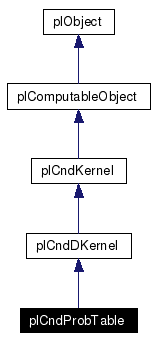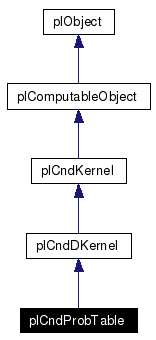
#include <plCndProbTable.h>
Inheritance diagram for plCndProbTable:


Public Member Functions | |
| plCndProbTable (const plVariablesConjunction &left, const plVariablesConjunction &right) | |
| Constructs a Conditional Probability Table on variables {left} having {n} possible values. | |
| plCndProbTable (const plVariablesConjunction &left, const plVariablesConjunction &right, const plExternalFunction &fknown) | |
| Constructs a Conditional Probability Table on Variables {left} having {n} possible values. | |
| virtual | ~plCndProbTable () |
| Destructor. | |
Protected Member Functions | |
| plCndProbTable () | |
| Default void constructor. | |
When instantiated, this class returns a {plProbTable}.
Definition at line 42 of file plCndProbTable.h.
|
||||||||||||
|
Constructs a Conditional Probability Table on variables {left} having {n} possible values.
The values of the probability table are fixed by those of the {n} variables {right}. example: plCndProbTable p(H | B1^B2^...^Bn); where {H} can take n values: 1, ..., n. When it is instantiated with B1 = b1, ..., Bn = bn, it constructs a probability table on P(H) with the values:
In multi-dimensional cases ({H = H1^H2}), where {H1} and {H2} can take n and m values respectively, the values {bi} for p(H1^H2 | B1^B2^...^Bn*m) are taken so that:
|
|
||||||||||||||||
|
Constructs a Conditional Probability Table on Variables {left} having {n} possible values.
The values of the probability table are fixed by calling the n-dimensional external function {fknown} on the the values of the {m} variables {right}. example: plCndProbTable p(H | X1^X2^...^Xm, fknown); where H can take n values: 0, 1, ..., n-1. When it is instantiated with X1 = x1, X2 = x2, ...., Xm = xm, it constructs the probability table on P(H) with the values:
In multi-dimensional cases ({H = H1^H2}), where {H1} and {H2} can take n1 and n2 values respectively, it constructs the probability table on P(H) with the values:
|
 1.4.1
1.4.1